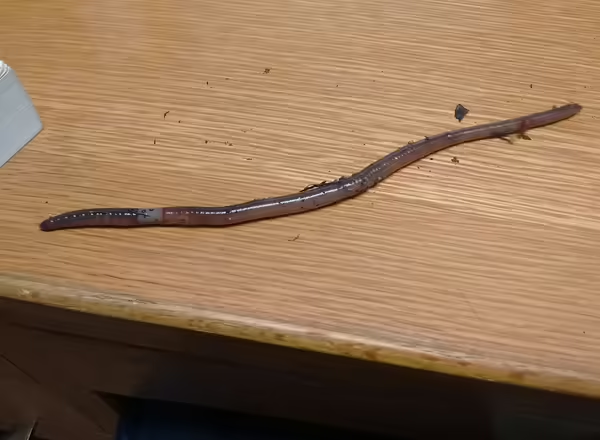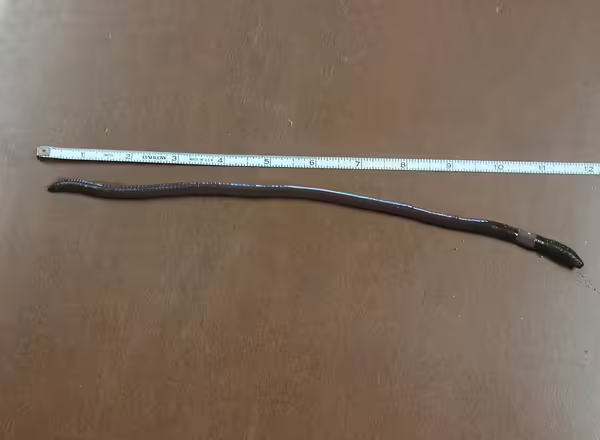
Adult worms are most active from mid-summer to the first freeze. Jumping worms live primarily in the leaf litter or in the top 3 to 4 inches of soil in wooded areas, garden bed, and lawns. You can often see jumping worms crawling on the soil surface or across sidewalks or pavement after heavy rains.
Adult jumping worms are usually 4 to 8 inches in length. The body is smooth, glossy, and dark brown in color. The clitellum band can be cloudy-white in color, especially on larger worms. This band fully encircles the body and is flush, not raised. The clitellum starts around the 14th segment of the body. On the other commonly encountered large worms in Illinois, the clitellum usually starts around the 20th segment or further back. Jumping worms will move via a side-to-side motion, somewhat like a snake. When disturbed, jumping worms can thrash wildly and even shed their tail.
Areas with high jumping worm populations can have soil that looks like dry, grainy coffee grounds.
Jumping worms are earthworms native to East Asia that have been sold in the U.S. for vermiculture or as fishing bait. Other names used for this group include called crazy worms, Alabama jumper, or snake worms. Jumping worms, named for their thrashing behavior, are highly invasive and detrimental. Adults reach maturity in as little as 60 days, with populations doubling in the growing season. They can reproduce without mating and eggs survive Illinois winters.
The worms are voracious eaters that consume the top layer of organic matter and quickly convert the soil into grainy castings that look like dry coffee grounds. They change the soil structure, deplete available nutrients, damage plant roots, and alter water holding capacity of the soil. Changing the soil has a ripple effect across ecosystems. Environmental scientists are concerned about the effect jumping worms will have on natural and landscaped areas.
This webinar, presented by University of Illinois Extension Forester Chris Evans, covers the identification, ecology, distribution, and impacts of jumping worms, a new invasive species in Illinois.

Unfortunately, there are no approved, research-based chemical treatments for managing jumping worms. Populations can be reduced in garden bed by hand-removing worms, but that is labor intensive and will not eradicate a population. Spread prevention practices are recommended to slow the spread of jumping worms in Illinois.
- Do not buy or use jumping worms for bait or vermicomposting.
- Only use heat-treated commercial compost or mulch. Do not share home compost, mulch, or plants.
- Carefully inspect any new plants before installing.
- Arrive clean, leave clean. Clean soil off of equipment and shoes, especially if working at multiple garden sites.
If you have jumping worms, gardeners should remove soil and wash plant roots before transplanting them to another part of the year to prevent spread. Maintain organic matter for plant health by regularly fertilizing and mulching.

Report populations of jumping worms in unconfirmed counties, see map, by taking a few clear, well-lit photos, including a closeup of the clitellum band. Note the county, location, and habitat where it was found. Include details such as how many worms were found or if the soil was impacted. Send reports to:
- University of Illinois Plant Clinic at plantclinic@illinois.edu or call (217) 333-0519
- Illinois Extension Forester Chris Evans at cwevans@illinois.edu or call (618) 695-3383
- Your local county Illinois Extension office, go.illinois.edu/ExtensionOffice